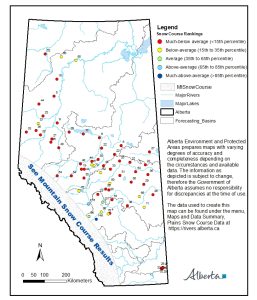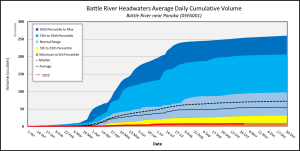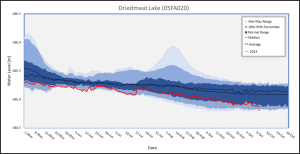March 26, 2024
By Morgan Lievers, BRWA Environmental Program Coordinator
The entire Battle River watershed is under a water shortage advisory. Historically, the Battle River has variable flows but El Niño conditions resulted in below average precipitation levels. Precipitation is the primary supply for the river. As of February 2024, drought conditions in the Battle River and Sounding Creek watersheds are categorized as severe (D2) to extreme (D3), and conditions in the Special Areas are categorized as exceptional (D4).
On April 25, 2024, the Government of Alberta released with an update of the Agricultural Moisture Situation in the province. The report states that the consistent warmth and dryness of the soil has generally continued due to the lack of rainfall that has been experienced across the province. The Battle River Watershed agricultural region remains “critically dry.” This is attributed to the lack of snowpack over the winter and the early melt in spring. Soil moisture reserves have also been at some of their lowest, states this report. While it is impossible to say for certain what this year’s weather will bring, we know that we are in desperate need of rain and snow in the upcoming year to replenish our soil moisture.
This winter’s snowpack (Figure 1) has been below average for the majority of the watershed. Snowpack was at a record low in several areas in the watershed. Bigstone, for example, had a snow water equivalent of 27 this year compared to the historical average of 69 making it rank as the third lowest snowpack over 50 years.

Municipalities, agriculture, and industry are some of the major users of water for the watershed. The provincial government has asked all major water license holders to establish a plan for water use and sharing if needed. As a result, ongoing monitoring and analysis of water availability is important.
Water levels in both the Battle River and Sounding Creek fluctuate throughout the year primarily due to precipitation and evaporation. In 2023, water volumes for the Battle River hovered around the 5th percentile (Figure 2; 2023 volumes shown with the red line). This represents very low flow volumes that occur on average once every 20 years. With less spring and summer precipitation, levels in Dried Meat Lake (Figure 3) were below the normal range for the beginning of the summer. With some rain over the summer, levels recovered slightly going into the fall. Overall, water levels were well below the long-term average last year.
Current levels can be monitored on the Alberta Rivers website or app.


Precipitation is difficult to predict and the current conditions have not brought good news for the upcoming summer.
A study done on climate change effects on Alberta found that as global temperatures rise, the grassland and parkland regions will experience a decrease in precipitation. Increasing temperatures are also predicted to be a determining factor for drought and water scarcity. When there has not been enough moisture for soil during the winter, it will impact the potential to absorb water. If there are more intense rainstorms in the spring after a dry winter, the potential for flooding will increase.
Last year’s drought provided the conditions for an intense wildfire season. The predictions for this year’s wildfires are expected to be similar. Alberta Wildfires have been preparing for the upcoming season by adding more resources, training, and FireSmart education.
Wildfire smoke can not be controlled like other air pollutants. Exposure to smoke can lead to serious health impacts and people with pre-existing conditions will be the most vulnerable. Last year, Camrose was ranked 11th in the most polluted regional centres of Canada. To prepare for the wildfire season it is recommended to invest in indoor air filtering solutions early and to regularly monitor air quality.
During drought, everyone plays an important role in water management to ensure we can meet the needs of communities with the water supply we have.
Local governments are the first line of defense for drought management. The municipality is responsible for the distribution of water to communities. By regularly monitoring forecasts and updates from the provincial government, municipalities can implement water conservation measures and water shortage plans. Most municipalities are currently in the process of developing these plans. The City of Camrose has a water shortage plan to outline the process of declaring shortages, conducting enforcement, and enabling policy into bylaws to prepare for potential water restrictions. Municipalities can also promote ways to mitigate the impacts of drought by increasing natural infrastructures. Structures like rain gardens, stormwater ponds, or wetlands can play a significant role in water management during drought.
Producers in the watershed are one of the most impacted industries in droughts. The best management practice to mitigate risks is to have a drought preparedness plan during normal conditions, regularly monitor conditions, and take immediate actions to reduce impacts. Drought is a common occurrence so it is important to integrate drought management into operational decisions. For grazing strategies during drought, the Beef Cattle Research Council has many resources to assist producers. The Government of Alberta provides updates on conditions and funding opportunities for producers during times of stress.
In times of water shortages, it is important to do your part to conserve water for the community. There are many municipalities that rely on the Battle River as a drinking water source and during drought there can be a limited supply of water that impacts everyone. The Government of Alberta has water conservation tips such as taking shorter showers, fixing leaks, and planting drought tolerant plants. Water wise landscaping can also help build resilience in urban communities. Using rain gardens or other landscaping techniques can help conserve water, and a great example can be found in the Pigeon Lake Watershed Association’s Clean Runoff Action Guide.
The Government of Alberta has been preparing for the upcoming drought by discussing water sharing agreements and introducing a new drought advisory committee to provide support for communities in conserving and managing water. Resources and information are also being consistently updated on the drought page.
The Alliance has been a part of many initiatives to promote drought planning and preparedness. We worked with the North Saskatchewan and Red Deer River Watershed Alliances to host two workshops to share information on building resiliency to multi-year drought. We also have our Riparian CARE program for landowners interested in using natural infrastructure to mitigate drought. BRWA is available to provide support and resources to communities planning their drought management. If you are interested, contact us.